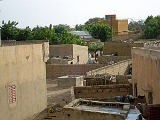
Agnam-Goly
Encyclopedia
Agnam-Goly is a Sahel
ian village in north-eastern Senegal
with a population of inhabitants. The village is located in the Ranérou Ferlo Department
of Matam Region
, approximately 630 kilometres (391.5 mi) to the northeast of Dakar
, on the bank of the Senegal River
.
 Agnam-Goly was founded by the Thioye family well before the year 1529. The Thioye began to inhabit caves in the dieri to the south of the village, over 12 meters (40 feet) above the ground. These caves, protected from the elements by large rocks, can still be visited today. The early inhabitants of Agnam-Goly left behind a mosque
Agnam-Goly was founded by the Thioye family well before the year 1529. The Thioye began to inhabit caves in the dieri to the south of the village, over 12 meters (40 feet) above the ground. These caves, protected from the elements by large rocks, can still be visited today. The early inhabitants of Agnam-Goly left behind a mosque
surrounded by a stone wall before moving north to the walo, which is the site used by the village today for agriculture
and fishing
.
At first, the village consisted of a single hearth
surrounded by huts, each of which housed one family. This arrangement served to strengthen family ties and encourage solidarity between neighbors. These early structures, some of which are still standing, are located in the center of the modern village of Agnam-Goly.
The village contains six traditional quarters, each with its own prominent family: Diobé-Barrobé, Saarbé, Salsalbé, Gadiobé, Koundiobé and Sinthiou.
 When Fouta was conquered by Koli Teŋella in the sixteenth century, Agnam-Goly – like the other Agnam villages – was already a fair-sized town. As Oumar Kane notes:
When Fouta was conquered by Koli Teŋella in the sixteenth century, Agnam-Goly – like the other Agnam villages – was already a fair-sized town. As Oumar Kane notes:
“The West Booseya extends from Hoorefoonde to Bokijawe. This is a stretch of village communities, some of which are true towns : the Aañam [Wuro-Moolo, Goli, Liiduɓe, Coɗay, Wuro-Sira, Siwol, Godo, Tulel-Calle, Ɓaarga], the large grouping of Cilon, Daabia Odeeji, Kobillo, Gudduɗe-Joobbe and Gudduɗe Ndueetɗe, Voki-Jawe.”
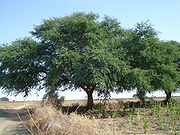 “Dooroy” is located in the walo and “Boda-ngal” in the dieri. These two mythical places are inhabited by the spirit
“Dooroy” is located in the walo and “Boda-ngal” in the dieri. These two mythical places are inhabited by the spirit
of the legendary "Mbaroodi Dooroy" who migrates back and forth between Dooroy and Boda-ngal with the flooding and receding of the Sénégal River
. Whether he is in Dooroy or in Boda-ngal, the Mbaroodi Dooroy can never live anywhere but in a well
or spring
. The Dooroy contains a little stream
running through a dense forest of acacia trees, not far from Tain-ngu pond. The Boda-ngal contains the Biidal pond and the cemetery
.
This Mbaroodi Dooroy is a male spirit, who lost his male organs in a fight with the “Mbaroodi Maayel Barga”, taking one of his opponent's eyes in revenge. The two spirits are separated by the Barga pond. During a long dry season, the Mbaroodi Dooroy tried in vain to conquer this pond. And using a dream as an intermediary, he commanded the villagers to dig a well for him in the Dooroy and to pour milk into it as an offering. At the same time, he issued this warning:
“You shall not wash your mats and pots there, newly married and pregnant women shall not approach the well, and above all, you shall not urinate there.”
When the Sénégal River floods, his favorite spot, “Boorti Thioura”, is always in motion: the water moves and its depth is unimaginable.
At times of need, the wise elders of the village invoke the Mbaarodi Dooroy by means of a secret formula that begins with the words “Yaa Dooroy, yaa Boda-ngal...”, and their sacred clay.
 Agnam-Goly is located in northeastern Senegal
Agnam-Goly is located in northeastern Senegal
, on the southern bank of the Senegal River
. It is traversed by the N2 highway, which links Matam
(to the southeast) with Dagana
(to the northwest), passing between the villages of Thilogne and Pete Ngour.
The village belongs to the rural community and to the district of Agnam Civol, in the Ranérou Ferlo Department
of the Matam Region
.
The altitude, which ranges from ten to thirteen meters (32 to 42 feet), averages twelve meters (39 feet).
The village is located between the walo, a clayey, flood-prone area, to the north and the dieri, formed by sand dunes studded with rocks, to the south.
Professor Oumar Kane of the Cheikh Anta Diop University, a Fouta-Toro
specialist, describes the importance of water in this region, which draws much of its resources from flood-based agriculture:
"From Duumga to Mbaan, the low floodplain spreads as far as the eye can see, extending over 50 kilometers. This explains the dense concentration of jeejegol villages between Duumga and Hoorefoonde: Vokijawe, Dabia-Koɓvillo, Cilon, Kaaƴe-Pawe, Ɓaarga, Tulel-Calle, Godo, Siwol, Wuro-Siree, Coɗay, Goli, Wuro-Molo, Liiduɓe, Asnde Balla, Njaakir, Hooƴo, etc."
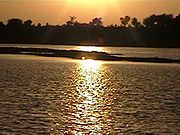
Agnam-Goly is located in the Sahel
region of Senegal
. It has a tropical climate
with a dry period that divides the year into two seasons, with continuous sunlight throughout.
The dry season
lasts from early November to late June. This is when the harmattan
, a hot, dry wind from the east, drives back the alizé, a cool, humid wind from the south-southwest. The harmattan brings heat – with temperatures above 43°C (109°F) – and dryness, so that there is little or no precipitation.
The wet season
lasts from early July to late October. During this time, the alizé comes from the southwest, bringing monsoon
winds that cool the air, and heavy rain. Wet season temperatures alternate between hot and cool, with lows reaching 21°C (70°F).
Almost all of Agnam-Goly's precipitation falls during the wet season, but the rains begin slightly earlier, in August. For many years, rainfall has been decreasing, and the first rains arrive later in the season, which is a source of worry for the local people.
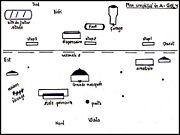 The village of Agnam-Goly is traversed by the N2 national highway and possesses the following infrastructure and services:
The village of Agnam-Goly is traversed by the N2 national highway and possesses the following infrastructure and services:
Remittances from relatives who have emigrated have allowed many of Agnam-Goly's residents to build living quarters on the roof or second floor of their houses.
 In 2003, Agnam-Goly had a population of inhabitants, divided among 318 households.
In 2003, Agnam-Goly had a population of inhabitants, divided among 318 households.
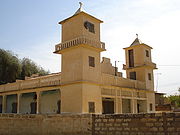 The presence of traditional myths does not interfere with the practice of Islam
The presence of traditional myths does not interfere with the practice of Islam
, which is the principal religion of the village.
The Council of Elders also has jurisdiction over agriculture, social issues, sanitation, education, etc., and thus serves as the ultimate judge and manages the daily government of the village.
The Chief works in concert with the Council of Elders. He represents the village on administrative issues, and can act in its name. The Chief has the right to convoke the Council of Elders, who must respect his summons. He keeps the Great Drum of the village, along with a town crier. The Chief owns great fields of fertile land, and can call upon the work of every villager. He delivers the verdicts of the Council of Elders.
 Ndoussoudji is an extension of the village that is located in the dieri, 35 kilometres (21.7 mi) from Agnam-Goly. Approximately ten families go there in wagons during the wet season
Ndoussoudji is an extension of the village that is located in the dieri, 35 kilometres (21.7 mi) from Agnam-Goly. Approximately ten families go there in wagons during the wet season
to cultivate the land and graze their livestock. Ndoussoudji has now become a small village, with a large well and herds of livestock. The buildings there are made of baked earth thatched with dry grass, except for the mosque which is built in cement. The water tower
ensures a supply of potable water for the village.
 The elementary school of Agnam-Goly was founded in 1960. It originally had two classrooms. Today, it has twelve classrooms, some of which have electricity; a small library; two large courtyards for recreation; toilets and living quarters for the director of the school. 593 children attended the school in the 2006-2007 school year: 221 girls and 372 boys, divided into twelve classes with one teacher per class. Learning conditions are difficult for many reasons: overcrowding (three students share a bench and a single book), high student/teacher ratio, lack of teaching materials, and limited resources of the Parents Association which supports the school.
The elementary school of Agnam-Goly was founded in 1960. It originally had two classrooms. Today, it has twelve classrooms, some of which have electricity; a small library; two large courtyards for recreation; toilets and living quarters for the director of the school. 593 children attended the school in the 2006-2007 school year: 221 girls and 372 boys, divided into twelve classes with one teacher per class. Learning conditions are difficult for many reasons: overcrowding (three students share a bench and a single book), high student/teacher ratio, lack of teaching materials, and limited resources of the Parents Association which supports the school.
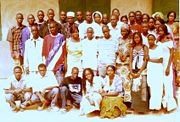 The village's 67 junior high school students attend the Agnam high school, three kilometers' (1.5 miles') walk from the village, while the 27 high school students attend the high schools of Matam
The village's 67 junior high school students attend the Agnam high school, three kilometers' (1.5 miles') walk from the village, while the 27 high school students attend the high schools of Matam
and Thilogne. Most of the village's 21 university students attend the Cheikh Anta Diop University
in Dakar
, and study liberal arts, social sciences, law, economics, medicine, natural sciences and engineering. It is often difficult for them to find lodging and participate fully in university life.
The Coranic school also contributes to the education of the young people of the village.
For decades the students of Agnam-Goly have left their studies for migrant work. Nevertheless, the village has many students today thanks to its promotion of education: building classrooms, providing electricity and teaching materials for the school, organizing workshops in Dakar
to introduce its students to computers and the Internet, and building a ten-room house for volunteer teachers.
literacy teachers are very active in promoting culture through theater, awareness days, and traditional ceremonies.
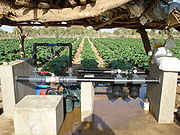 The villagers of Agnam-Goly cultivate sorghum
The villagers of Agnam-Goly cultivate sorghum
, corn
, beans and watermelons in the walo following the seasonal flooding of the Sénégal River
. During the wet season
, millet
, beans, bissap
, melon
, and sorghum
are grown in the dieri.
Agriculture in the village is undergoing a crisis, because rainfall has decreased, irrigation is insufficient, the soil is depleted of nutrients, the price of fertilizer is high, and locusts and other pests attack crops. Nevertheless, horticulture gardening is expected to benefit the village over the coming years.
 In addition to agriculture, the villagers engage extensively in livestock herding, consisting mainly of cattle, sheep, and goats. Poultry raising is uncommon, as is commercial trading.
In addition to agriculture, the villagers engage extensively in livestock herding, consisting mainly of cattle, sheep, and goats. Poultry raising is uncommon, as is commercial trading.
The village depends on migrant labor for its subsistence. These migrants support their families by sending monthly remittances, which are used to buy food and pay for school and health care.
Sahel
The Sahel is the ecoclimatic and biogeographic zone of transition between the Sahara desert in the North and the Sudanian Savannas in the south.It stretches across the North African continent between the Atlantic Ocean and the Red Sea....
ian village in north-eastern Senegal
Senegal
Senegal , officially the Republic of Senegal , is a country in western Africa. It owes its name to the Sénégal River that borders it to the east and north...
with a population of inhabitants. The village is located in the Ranérou Ferlo Department
Ranérou Ferlo Department
' is one of the departments of Senegal, located in the Matam Region of the country. Settlements located within the department include the capital Ranérou and Agnam-Goly....
of Matam Region
Matam Region
Matam is a region of Senegal .It is a stark, flat, arid place bounded on the north by the Sénégal River and the south by the Sahelian plain studded with baobab trees made famous in Le Petit Prince...
, approximately 630 kilometres (391.5 mi) to the northeast of Dakar
Dakar
Dakar is the capital city and largest city of Senegal. It is located on the Cap-Vert Peninsula on the Atlantic coast and is the westernmost city on the African mainland...
, on the bank of the Senegal River
Sénégal River
The Sénégal River is a long river in West Africa that forms the border between Senegal and Mauritania.The Sénégal's headwaters are the Semefé and Bafing rivers which both originate in Guinea; they form a small part of the Guinean-Malian border before coming together at Bafoulabé in Mali...
.
Founding

Mosque
A mosque is a place of worship for followers of Islam. The word is likely to have entered the English language through French , from Portuguese , from Spanish , and from Berber , ultimately originating in — . The Arabic word masjid literally means a place of prostration...
surrounded by a stone wall before moving north to the walo, which is the site used by the village today for agriculture
Agriculture
Agriculture is the cultivation of animals, plants, fungi and other life forms for food, fiber, and other products used to sustain life. Agriculture was the key implement in the rise of sedentary human civilization, whereby farming of domesticated species created food surpluses that nurtured the...
and fishing
Fishing
Fishing is the activity of trying to catch wild fish. Fish are normally caught in the wild. Techniques for catching fish include hand gathering, spearing, netting, angling and trapping....
.
At first, the village consisted of a single hearth
Hearth
In common historic and modern usage, a hearth is a brick- or stone-lined fireplace or oven often used for cooking and/or heating. For centuries, the hearth was considered an integral part of a home, often its central or most important feature...
surrounded by huts, each of which housed one family. This arrangement served to strengthen family ties and encourage solidarity between neighbors. These early structures, some of which are still standing, are located in the center of the modern village of Agnam-Goly.
The village contains six traditional quarters, each with its own prominent family: Diobé-Barrobé, Saarbé, Salsalbé, Gadiobé, Koundiobé and Sinthiou.

“The West Booseya extends from Hoorefoonde to Bokijawe. This is a stretch of village communities, some of which are true towns : the Aañam [Wuro-Moolo, Goli, Liiduɓe, Coɗay, Wuro-Sira, Siwol, Godo, Tulel-Calle, Ɓaarga], the large grouping of Cilon, Daabia Odeeji, Kobillo, Gudduɗe-Joobbe and Gudduɗe Ndueetɗe, Voki-Jawe.”
Myth of Dooroy and Boda-ngal
The myth of Dooroy and Boda-ngal is still alive in Agnam-Goly:
Spirit
The English word spirit has many differing meanings and connotations, most of them relating to a non-corporeal substance contrasted with the material body.The spirit of a living thing usually refers to or explains its consciousness.The notions of a person's "spirit" and "soul" often also overlap,...
of the legendary "Mbaroodi Dooroy" who migrates back and forth between Dooroy and Boda-ngal with the flooding and receding of the Sénégal River
Sénégal River
The Sénégal River is a long river in West Africa that forms the border between Senegal and Mauritania.The Sénégal's headwaters are the Semefé and Bafing rivers which both originate in Guinea; they form a small part of the Guinean-Malian border before coming together at Bafoulabé in Mali...
. Whether he is in Dooroy or in Boda-ngal, the Mbaroodi Dooroy can never live anywhere but in a well
Water well
A water well is an excavation or structure created in the ground by digging, driving, boring or drilling to access groundwater in underground aquifers. The well water is drawn by an electric submersible pump, a trash pump, a vertical turbine pump, a handpump or a mechanical pump...
or spring
Spring (hydrosphere)
A spring—also known as a rising or resurgence—is a component of the hydrosphere. Specifically, it is any natural situation where water flows to the surface of the earth from underground...
. The Dooroy contains a little stream
Stream
A stream is a body of water with a current, confined within a bed and stream banks. Depending on its locale or certain characteristics, a stream may be referred to as a branch, brook, beck, burn, creek, "crick", gill , kill, lick, rill, river, syke, bayou, rivulet, streamage, wash, run or...
running through a dense forest of acacia trees, not far from Tain-ngu pond. The Boda-ngal contains the Biidal pond and the cemetery
Cemetery
A cemetery is a place in which dead bodies and cremated remains are buried. The term "cemetery" implies that the land is specifically designated as a burying ground. Cemeteries in the Western world are where the final ceremonies of death are observed...
.
This Mbaroodi Dooroy is a male spirit, who lost his male organs in a fight with the “Mbaroodi Maayel Barga”, taking one of his opponent's eyes in revenge. The two spirits are separated by the Barga pond. During a long dry season, the Mbaroodi Dooroy tried in vain to conquer this pond. And using a dream as an intermediary, he commanded the villagers to dig a well for him in the Dooroy and to pour milk into it as an offering. At the same time, he issued this warning:
“You shall not wash your mats and pots there, newly married and pregnant women shall not approach the well, and above all, you shall not urinate there.”
When the Sénégal River floods, his favorite spot, “Boorti Thioura”, is always in motion: the water moves and its depth is unimaginable.
At times of need, the wise elders of the village invoke the Mbaarodi Dooroy by means of a secret formula that begins with the words “Yaa Dooroy, yaa Boda-ngal...”, and their sacred clay.
Location

Senegal
Senegal , officially the Republic of Senegal , is a country in western Africa. It owes its name to the Sénégal River that borders it to the east and north...
, on the southern bank of the Senegal River
Sénégal River
The Sénégal River is a long river in West Africa that forms the border between Senegal and Mauritania.The Sénégal's headwaters are the Semefé and Bafing rivers which both originate in Guinea; they form a small part of the Guinean-Malian border before coming together at Bafoulabé in Mali...
. It is traversed by the N2 highway, which links Matam
Matam
Matam may refer to:*Bramham Gari Matham, a pilgrim in India.*Matam, Senegal, a city in Senegal*Matam, Haifa, a business park in Haifa, Israel*Matam, Guinea, a district of the capital Conakr...
(to the southeast) with Dagana
Dagana
* Dagana, Senegal a town* Dagana Department, Senegal* Dagana River, Senegal* Dagana Department, Chad* Dagana District, Bhutan...
(to the northwest), passing between the villages of Thilogne and Pete Ngour.
The village belongs to the rural community and to the district of Agnam Civol, in the Ranérou Ferlo Department
Ranérou Ferlo Department
' is one of the departments of Senegal, located in the Matam Region of the country. Settlements located within the department include the capital Ranérou and Agnam-Goly....
of the Matam Region
Matam Region
Matam is a region of Senegal .It is a stark, flat, arid place bounded on the north by the Sénégal River and the south by the Sahelian plain studded with baobab trees made famous in Le Petit Prince...
.
The altitude, which ranges from ten to thirteen meters (32 to 42 feet), averages twelve meters (39 feet).
The village is located between the walo, a clayey, flood-prone area, to the north and the dieri, formed by sand dunes studded with rocks, to the south.
Professor Oumar Kane of the Cheikh Anta Diop University, a Fouta-Toro
Futa Tooro
Futa Tooro refers to the region on the Senegal River in what is now northern Senegal and southern Mauritania.The word Fuuta was a general name the Fulbe gave to any area they lived in, while Tooro was the actual identity of the region for its inhabitants. The people of the kingdom spoke Pulaar, a...
specialist, describes the importance of water in this region, which draws much of its resources from flood-based agriculture:
"From Duumga to Mbaan, the low floodplain spreads as far as the eye can see, extending over 50 kilometers. This explains the dense concentration of jeejegol villages between Duumga and Hoorefoonde: Vokijawe, Dabia-Koɓvillo, Cilon, Kaaƴe-Pawe, Ɓaarga, Tulel-Calle, Godo, Siwol, Wuro-Siree, Coɗay, Goli, Wuro-Molo, Liiduɓe, Asnde Balla, Njaakir, Hooƴo, etc."
Climate

Agnam-Goly is located in the Sahel
Sahel
The Sahel is the ecoclimatic and biogeographic zone of transition between the Sahara desert in the North and the Sudanian Savannas in the south.It stretches across the North African continent between the Atlantic Ocean and the Red Sea....
region of Senegal
Senegal
Senegal , officially the Republic of Senegal , is a country in western Africa. It owes its name to the Sénégal River that borders it to the east and north...
. It has a tropical climate
Tropical climate
A tropical climate is a climate of the tropics. In the Köppen climate classification it is a non-arid climate in which all twelve months have mean temperatures above...
with a dry period that divides the year into two seasons, with continuous sunlight throughout.
The dry season
Dry season
The dry season is a term commonly used when describing the weather in the tropics. The weather in the tropics is dominated by the tropical rain belt, which oscillates from the northern to the southern tropics over the course of the year...
lasts from early November to late June. This is when the harmattan
Harmattan
The Harmattan is a dry and dusty West African trade wind. It blows south from the Sahara into the Gulf of Guinea between the end of November and the middle of March...
, a hot, dry wind from the east, drives back the alizé, a cool, humid wind from the south-southwest. The harmattan brings heat – with temperatures above 43°C (109°F) – and dryness, so that there is little or no precipitation.
The wet season
Wet season
The the wet season, or rainy season, is the time of year, covering one or more months, when most of the average annual rainfall in a region occurs. The term green season is also sometimes used as a euphemism by tourist authorities. Areas with wet seasons are dispersed across portions of the...
lasts from early July to late October. During this time, the alizé comes from the southwest, bringing monsoon
Monsoon
Monsoon is traditionally defined as a seasonal reversing wind accompanied by corresponding changes in precipitation, but is now used to describe seasonal changes in atmospheric circulation and precipitation associated with the asymmetric heating of land and sea...
winds that cool the air, and heavy rain. Wet season temperatures alternate between hot and cool, with lows reaching 21°C (70°F).
Almost all of Agnam-Goly's precipitation falls during the wet season, but the rains begin slightly earlier, in August. For many years, rainfall has been decreasing, and the first rains arrive later in the season, which is a source of worry for the local people.
Infrastructure and Public Services

- A school with twelve classrooms, six of which were built by the village with locally raised funds, with partial connection to electricity;
- A health clinic equipped with an ambulance that is currently out of service;
- A borehole and six wells;
- A credit and savings mutualMutual organizationA mutual, mutual organization, or mutual society is an organization based on the principle of mutuality. Unlike a true cooperative, members usually do not contribute to the capital of the company by direct investment, but derive their right to profits and votes through their customer relationship...
, managed by the women of Agnam-Goly (DGL MEC Felo Agnam); - A soccer field, where the village plans to build a stadium; and
- A central marketMarketA market is one of many varieties of systems, institutions, procedures, social relations and infrastructures whereby parties engage in exchange. While parties may exchange goods and services by barter, most markets rely on sellers offering their goods or services in exchange for money from buyers...
and a weekly market.
Remittances from relatives who have emigrated have allowed many of Agnam-Goly's residents to build living quarters on the roof or second floor of their houses.
Demography

Religion

Islam
Islam . The most common are and . : Arabic pronunciation varies regionally. The first vowel ranges from ~~. The second vowel ranges from ~~~...
, which is the principal religion of the village.
The Council of Elders
Governing power belongs to the Council of Elders, which is composed of prominent members of the six traditional quarters of the village. The Council of Elders selects the Chief of the village and removes him in the case of serious incapacity, or if he proves incompetent in his duties of mediating disputes between villagers.The Council of Elders also has jurisdiction over agriculture, social issues, sanitation, education, etc., and thus serves as the ultimate judge and manages the daily government of the village.
The Chief of the Village
The Chief of the village is traditionally chosen by the Council of Elders from the “royal” Sall family. The Chief serves for life, but in case of incapacity, he is obliged to return his status to the Council of Elders, as the position is not hereditary. The Sarr family organizes the traditional inauguration of the Chief, which is a great ceremony. If there is a dispute over his successor, the chieftainship is turned over to this family until the Council of Elders agrees on the selection of a new Chief. The Chief of the village carries the title “Diagaraph”, and every man of the Sall family carries the title of “Lawahé” or Prince.The Chief works in concert with the Council of Elders. He represents the village on administrative issues, and can act in its name. The Chief has the right to convoke the Council of Elders, who must respect his summons. He keeps the Great Drum of the village, along with a town crier. The Chief owns great fields of fertile land, and can call upon the work of every villager. He delivers the verdicts of the Council of Elders.
The seasonal village of Ndoussoudji

Wet season
The the wet season, or rainy season, is the time of year, covering one or more months, when most of the average annual rainfall in a region occurs. The term green season is also sometimes used as a euphemism by tourist authorities. Areas with wet seasons are dispersed across portions of the...
to cultivate the land and graze their livestock. Ndoussoudji has now become a small village, with a large well and herds of livestock. The buildings there are made of baked earth thatched with dry grass, except for the mosque which is built in cement. The water tower
Water tower
A water tower or elevated water tower is a large elevated drinking water storage container constructed to hold a water supply at a height sufficient to pressurize a water distribution system....
ensures a supply of potable water for the village.
Education


Matam
Matam may refer to:*Bramham Gari Matham, a pilgrim in India.*Matam, Senegal, a city in Senegal*Matam, Haifa, a business park in Haifa, Israel*Matam, Guinea, a district of the capital Conakr...
and Thilogne. Most of the village's 21 university students attend the Cheikh Anta Diop University
Cheikh Anta Diop University
Cheikh Anta Diop University , also known as the University of Dakar, is a university in Dakar, Senegal. It is named after the Senegalese historian and anthropologist Cheikh Anta Diop and has an enrollment of over 60,000.-History:...
in Dakar
Dakar
Dakar is the capital city and largest city of Senegal. It is located on the Cap-Vert Peninsula on the Atlantic coast and is the westernmost city on the African mainland...
, and study liberal arts, social sciences, law, economics, medicine, natural sciences and engineering. It is often difficult for them to find lodging and participate fully in university life.
The Coranic school also contributes to the education of the young people of the village.
For decades the students of Agnam-Goly have left their studies for migrant work. Nevertheless, the village has many students today thanks to its promotion of education: building classrooms, providing electricity and teaching materials for the school, organizing workshops in Dakar
Dakar
Dakar is the capital city and largest city of Senegal. It is located on the Cap-Vert Peninsula on the Atlantic coast and is the westernmost city on the African mainland...
to introduce its students to computers and the Internet, and building a ten-room house for volunteer teachers.
Traditions
Tradition and modernity coexist in Agnam-Goly. FulaFula people
Fula people or Fulani or Fulbe are an ethnic group spread over many countries, predominantly in West Africa, but found also in Central Africa and Sudanese North Africa...
literacy teachers are very active in promoting culture through theater, awareness days, and traditional ceremonies.
Economy and Development

Sorghum
Sorghum is a genus of numerous species of grasses, one of which is raised for grain and many of which are used as fodder plants either cultivated or as part of pasture. The plants are cultivated in warmer climates worldwide. Species are native to tropical and subtropical regions of all continents...
, corn
Maize
Maize known in many English-speaking countries as corn or mielie/mealie, is a grain domesticated by indigenous peoples in Mesoamerica in prehistoric times. The leafy stalk produces ears which contain seeds called kernels. Though technically a grain, maize kernels are used in cooking as a vegetable...
, beans and watermelons in the walo following the seasonal flooding of the Sénégal River
Sénégal River
The Sénégal River is a long river in West Africa that forms the border between Senegal and Mauritania.The Sénégal's headwaters are the Semefé and Bafing rivers which both originate in Guinea; they form a small part of the Guinean-Malian border before coming together at Bafoulabé in Mali...
. During the wet season
Wet season
The the wet season, or rainy season, is the time of year, covering one or more months, when most of the average annual rainfall in a region occurs. The term green season is also sometimes used as a euphemism by tourist authorities. Areas with wet seasons are dispersed across portions of the...
, millet
Millet
The millets are a group of small-seeded species of cereal crops or grains, widely grown around the world for food and fodder. They do not form a taxonomic group, but rather a functional or agronomic one. Their essential similarities are that they are small-seeded grasses grown in difficult...
, beans, bissap
Roselle (plant)
The roselle is a species of Hibiscus native to the Old World tropics, used for the production of bast fibre and as an infusion. It is an annual or perennial herb or woody-based subshrub, growing to tall...
, melon
Melon
thumb|200px|Various types of melonsThis list of melons includes members of the plant family Cucurbitaceae with edible, fleshy fruit e.g. gourds or cucurbits. The word "melon" can refer to either the plant or specifically to the fruit...
, and sorghum
Sorghum
Sorghum is a genus of numerous species of grasses, one of which is raised for grain and many of which are used as fodder plants either cultivated or as part of pasture. The plants are cultivated in warmer climates worldwide. Species are native to tropical and subtropical regions of all continents...
are grown in the dieri.
Agriculture in the village is undergoing a crisis, because rainfall has decreased, irrigation is insufficient, the soil is depleted of nutrients, the price of fertilizer is high, and locusts and other pests attack crops. Nevertheless, horticulture gardening is expected to benefit the village over the coming years.

The village depends on migrant labor for its subsistence. These migrants support their families by sending monthly remittances, which are used to buy food and pay for school and health care.
Village Associations
- Association des ressortissants d'Agnam-Goly en France (ARAGF)
- Association des jeunes d'Agnam-Goly (AJAG) ;
- Association des femmes d'Agnam-Goly (AFAG) ;
- Association des élèves et étudiants ressortissants d'Agnam-Goly (AEERAG) ;
- Dental Agnam-Goly en France.

